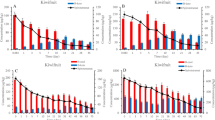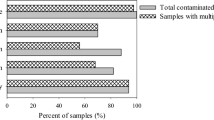Abstract
Forchlorfenuron (CPPU) is often applied during the cultivation of kiwifruit to produce larger fruit. To address degradation patterns of CPPU during simulated cold chain logistics and simulated shelf life of the fruit after harvest, appropriate storage methods and safe consumption behavior can be investigated. In this study, an ultra-high-performance liquid chromatography-tandem mass spectrometry method was adopted to detect CPPU residues under different conditions. CPPU in kiwifruit stored at 6 °C had a half-life of 40.8–77.0 days. However, when kiwifruit was stored at 0 °C under simulated cold chain storage conditions, the half-life of CPPU was 63.0–115.5 days, implying that lower storage temperatures can reduce the degradation rate of CPPU. The residues of CPPU in kiwifruit pulp declined with time, and the reduction followed the first-order kinetics equation. More CPPU residues were present in the pulp of postharvest kiwifruit treated with exogenous ethylene than in the pulp of untreated kiwifruit. Thus, using exogenous ethylene for artificial ripening after harvest is not recommended. We determined that the appropriate cold chain storage temperature is 6 °C. It is recommended that the public select kiwifruit stored for at least 2 weeks. The estimated chronic and acute dietary risk quotients of CPPU are ≤ 0.79% and ≤ 0.11%, respectively. Therefore, it is highly unlikely that consumers will be poisoned by CPPU due to kiwifruit consumption. Our results provide scientific evidence regarding the adoption of appropriate kiwifruit storage methods and consumption behavior to enhance consumption safety.






Similar content being viewed by others
Data availability
Supplementary data are available as Supplementary Material on the publisher’s website along with the published article.
References
Bu Q, Wang X, Xie H, Zhong K, Wu Y, Zhang J, Wang Z, Gao H, Huang Y (2019) 180 day repeated-dose toxicity study on forchlorfenuron in Sprague-Dawley rats and its effects on the production of steroid hormones. J Agric Food Chem 67:10207–10213. https://doi.org/10.1021/acs.jafc.9b03855
Cheng Y, Nie J, Li Z, Yan Z, Xu G, Li H, Guan D (2017) A molecularly imprinted polymer synthesized using β-cyclodextrin as the monomer for the efficient recognition of forchlorfenuron in fruits. Anal Bioanal Chem 409:5065–5072. https://doi.org/10.1007/s00216-017-0452-1
Domínguez M, Vendrell M (1994) Effect of ethylene treatment on ethylene production, EFE activity and ACC levels in peel and pulp of banana fruit. Postharvest Biol Tec 4:167–177. https://doi.org/10.1016/0925-5214(94)90018-3
Dong J, Guo W, Zhao F, Liu D (2017) Discrimination of “Hayward” kiwifruits treated with forchlorfenuron at different concentrations using hyperspectral imaging technology. Food Anal Method 10:477–486. https://doi.org/10.1007/s12161-016-0603-6
EU 398/2014 (2014) EU pesticides database [EB/OL]. Retrieved from https://eur-lex.europa.eu/legal-content/EN/ALL/?uri=CELEX:32014R0398. 2014-06-30
Fang Q, Wu R, Hu G, Lai A, Wu K, Zhang L, Feng J, Cao H (2020) Dissipation behavior, residue distribution and risk assessment of three fungicides in pears. J Sci Food Agric 100:1757–1763. https://doi.org/10.1002/jsfa.10199
Goffi V, Zampella L, Forniti R, Petriccione M, Botondi R (2019) Effects of ozone postharvest treatment on physicochemical and qualitative traits of Actinidia chinensis ‘Soreli’ during cold storage. J Sci Food Agric 99:5654–5661. https://doi.org/10.1002/jsfa.9823
Gong G, Kam H, Tse Y, Lee SM (2019) Cardiotoxicity of forchlorfenuron (CPPU) in zebrafish (Danio rerio) and H9c2 cardiomyocytes. Chemosphere. 235:153–162. https://doi.org/10.1016/j.chemosphere.2019.06.027
Heshmati A, Nili-Ahmadabadi A, Rahimi A, Vahidinia A, Taheri M (2020) Dissipation behavior and risk assessment of fungicide and insecticide residues in grape under open-field, storage and washing conditions. J Clean Prod 270:122287. https://doi.org/10.1016/j.jclepro.2020.122287
Huang Z, Guo L, Wang H, Qu H, Ma S, Liu Y, Huang H, Jiang Y (2014) Energy status of kiwifruit stored under different temperatures or exposed to long-term anaerobic conditions or pure oxygen. Postharvest Biol Tec 98:56–64. https://doi.org/10.1016/j.postharvbio.2014.07.008
IPCS. the International Programme on Chemical Safety [EB/OL] (2009) Principles and methods for the risk assessment of chemicals in food: environmental health criteria 240M.Sheffer (Ed.), Chapter 6: Dietary Exposure Assessment of Chemicals in Food, EPublishing, Inc., Stuttgart (2009), pp.68–95. https://www.scopus.com/inward/record.url?eid=2-s2.0-85049458315&partnerID=10&rel=R3.0.0
IUPAC Pesticide Properties DataBase [EB/OL] (2019) Retrieved from http://sitem.herts.ac.uk/aeru/iupac/Reports/358.htm, 2019-11-06
Lara I, Vendrell M (2003) Cold-induced ethylene biosynthesis is differentially regulated in peel and pulp tissues of ‘Granny Smith’ apple fruit. Postharvest Biol Tec 29:109–119. https://doi.org/10.1016/S0925-5214(02)00243-0
Lewis KA, Tzilivakis J, Warner D, Green A (2016) An international database for pesticide risk assessments and management. Hum Ecol Risk Assess 22:1050–1064. https://doi.org/10.1080/10807039.2015.1133242
Li P, Lu Y, Cao J, Li M, Yang C, Yan H (2020) Imidazolium ionic-liquid-modified phenolic resin for solid-phase extraction of thidiazuron and forchlorfenuron from cucumbers. J Chromatogr A 1623:461192. https://doi.org/10.1016/j.chroma.2020.461192
Li RJ, Liu TJ, Cui SH, Zhang SC, Yu JL, Song GC (2017) Residue behaviors and dietary risk assessment of dinotefuran and its metabolites in Oryza sativa by a new HPLC-MS/MS method. Food Chem 235:188–193. https://doi.org/10.1016/j.yrtph.2019.104416
Li M, Guo X, Chen Y, Zhang K, Bai Q, Gao Z, Long F (2020) The degradation of forchlorfenuron in the model kiwifruit juice by ultrasonic treatment. J Food Process Pres 44:e14424. https://doi.org/10.1111/jfpp.14424
Lin H, Liu X, Ma Y, Pang K, Hu J (2018) Residue analysis and dietary exposure risk assessment of tebufenozide in stem lettuce (Lactuca sativa L. var. angustana Irish). Food Chem Toxicol 120:64–70. https://doi.org/10.1016/j.fct.2018.06.057
Malhat FM (2020) Residues, dissipation and risk evaluation of spiroxamine in open-field-grown strawberries using liquid chromatography tandem mass spectrometry. Biomed Chromatogr 34:e4836. https://doi.org/10.1002/bmc.4836
Masís-Mora M, Beita-Sandí W, Rodríguez-Yáñez J, Rodríguez-Rodríguez C (2020) Validation of a methodology by LC-MS/MS for the determination of triazine, triazole and organophosphate pesticide residues in biopurification systems. J Chromatogr B 1156:122296. https://doi.org/10.1016/j.jchromb.2020.122296
Minas IS, Tanou G, Karagiannis E, Belghazi M, Molassiotis A (2016) Coupling of physiological and proteomic analysis to understand the ethylene- and chilling- induced kiwifruit ripening syndrome. Front Plant Sci 7:120. https://doi.org/10.3389/fpls.2016.00120
Ministry of Agriculture of the People’s Republic of China (MOA) (2004a) Guidelines on pesticide residue trials, NY/T 788-2004. China Agriculture Publishing Press, Beijing
Ministry of Agriculture of the People’s Republic of China (MOA) (2004b) Guideline on sampling for pesticide residue analysis, NY/T 789-2004. China Agriculture Publishing Press, Beijing
Mukherjee S, Tappe W, Weihermueller L, Hofmann D, Köppchen S, Laabs V, Schroeder T, Vereecken H, Burauel P (2016) Dissipation of bentazone, pyrimethanil and boscalid in biochar and digestate based soil mixtures for biopurification systems. Sci Total Environ 544:192–202. https://doi.org/10.1016/j.scitotenv.2015.11.111
Orellana-Silla A, Armenta S, de la Guardia M, Mercader JV, Esteve-Turrillas FA (2018) Development of immunosorbents for the analysis of forchlorfenuron in fruit juices by ion mobility spectrometry. Anal Bioanal Chem 410:5961–5967. https://doi.org/10.1007/s00216-018-1213-5
Pérez-Mayán L, Ramil M, Cela R, Rodríguez I (2020) Multiresidue procedure to assess the occurrence and dissipation of fungicides and insecticides in vineyard soils from Northwest Spain. Chemosphere. 261:127696. https://doi.org/10.1016/j.chemosphere.2020.127696
Pu CH, Lin SK, Chuang WC, Shyu TH (2018) Modified QuEChERS method for 24 plant growth regulators in grapes using LC-MS/MS. J Food Drug Anal 26:637–648. https://doi.org/10.1016/j.jfda.2017.08.001
SANTE/11813/2017. 2017. Guidance document on analytical quality control and method validation procedures for pesticide residues and analysis in food and feed. https://ec.europa.eu/food/sites/food/files/plant/docs/pesticides_mrl_guidelines_wrkdoc_2017-11813.pdf
Song L, Zhong Z, Han Y, Zheng Q, Qin Y, Wu Q, He X, Pan C (2020) Dissipation of sixteen pesticide residues from various applications of commercial formulations on strawberry and their risk assessment under greenhouse conditions. Ecotox Environ Safe 188:109842. https://doi.org/10.1016/j.ecoenv.2019.109842
The Chinese Nutrition Society, 2016. The Food Guide Pagoda for Chinese Residents. Available from http://dg.cnsoc.org/upload/images/source/20160519163856103.jpg [Accessed on Sep 07, 2020]. (in Chinese)
Tilahun S, Choi HR, Kwon H, Park SM, Park DS, Jeong CS (2020) Transcriptome analysis of ‘haegeum’ gold kiwifruit following ethylene treatment to improve postharvest ripening quality. Agronomy. 10:487. https://doi.org/10.3390/agronomy10040487
Xu X, Hou X, Han M, Qiu S, Li Y (2020) Simultaneous determination of multiclass plant growth regulators in fruits using the quick, easy, cheap, effective, rugged, and safe method and ultra-high performance liquid chromatography-tandem mass spectrometry. J Sep Sci 43:788–798. https://doi.org/10.1002/jssc.201900771
Yang J, Luo F, Zhou L, Sun H, Yu H, Wang X, Zhang X, Yang M, Lou Z, Chen Z (2020) Residue reduction and risk evaluation of chlorfenapyr residue in tea planting, tea processing, and tea brewing. Sci Total Environ 738:139613. https://doi.org/10.1016/j.scitotenv.2020.139613
You X, Li Y, Wang X, Xu J, Zheng X, Sui C (2017) Residue analysis and risk assessment of tebuconazole in jujube (Ziziphus jujuba mill). Biomed Chromatogr 31:e3917. https://doi.org/10.1002/bmc.3917
Yu J, Xu Z, Zhang C, Chen L, Hu X, Yu R, Wang X, Zhao X (2020) Dissipation behavior, residue distribution, and risk assessment of triflumizole and FM-6-1 in greenhouse strawberries and soil. Environ Sci Pollut Res 27:15165–15173. https://doi.org/10.1007/s11356-020-08034-6
Zeng H, Yang W, Lu C, Lin W, Zou M, Zhang H, Wan J, Huang X (2016) Effect of CPPU on carbohydrate and endogenous hormone levels in young macadamia fruit. PLoS One 11:e0158705. https://doi.org/10.1371/journal.pone.0158705
Zhang R, Cui B, Huang S (2015) Degradation of forchlorfenuron by nitrification and denitrification reactions in the gut and shell biofilm of Limnoperna fortunei. Ecotoxicology. 24:381–390. https://doi.org/10.1007/s10646-014-1386-4
Zhu D, Ping L, Shen X, Hong Y, Weng Q, He Q, Wang J, Wang J (2020) Effects of prepubertal exposure to forchlorfenuron through prenatal and postnatal gavage administration in developing Sprague-Dawley rats. Reprod Toxicol. https://doi.org/10.1016/j.reprotox.2020.09.009
Funding
This work was partially supported by the National Key Research and Development Program of China (2016YFD0401103) and the Zhejiang Provincial Natural Science Foundation of China (LY17H310004).
Author information
Authors and Affiliations
Contributions
Difeng Zhu: conceptualization, supervision, methodology, validation, writing–original draft, writing–review and editing, visualization, funding acquisition. Li Ping: methodology, validation, visualization, project administration. Renyun Qian: software, validation, investigation. Chao Chen: methodology, validation. Yawen Hong: investigation, methodology. Zhenxuan Tong: writing–original draft, investigation. Xiaochun Yang: conceptualization, supervision, writing–review & editing. All authors read and approved the final manuscript.
Corresponding author
Ethics declarations
Ethical approval and consent to participate
This study did not involve human or animal subjects; thus, ethical approval and patient consent were not required.
Consent to publish
Not applicable.
Competing interests
The authors declare that they have no competing interests.
Additional information
Responsible Editor: Philippe Garrigues
Publisher’s note
Springer Nature remains neutral with regard to jurisdictional claims in published maps and institutional affiliations.
Supplementary information
ESM 1
(DOCX 26 kb)
Rights and permissions
About this article
Cite this article
Zhu, D., Ping, L., Qian, R. et al. Dissipation behavior, residue dynamics, and dietary risk assessment of forchlorfenuron in postharvest kiwifruits during simulated cold chain logistics and store shelf life. Environ Sci Pollut Res 28, 20002–20011 (2021). https://doi.org/10.1007/s11356-020-11803-y
Received:
Accepted:
Published:
Issue Date:
DOI: https://doi.org/10.1007/s11356-020-11803-y




